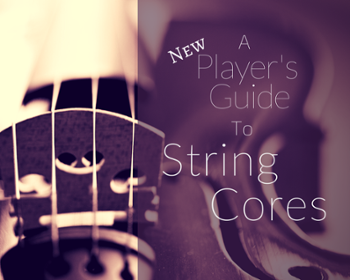 Strings are, not surprisingly, one of the most important features of any string instrument. Properly maintaining your instrument's strings is one of the easiest ways to ensure that your instrument is able to perform at its best.
Strings are, not surprisingly, one of the most important features of any string instrument. Properly maintaining your instrument's strings is one of the easiest ways to ensure that your instrument is able to perform at its best.
For most seasoned players, the semi-regular chore that is string replacement is a simple one. When their instrument's strings become worn, weathered, or damaged, they know exactly which types of strings they're going purchase. For new or younger players, this same task can prove somewhat challenging.
That's why we've put together a simple new player's guide featuring the most common core types (gut, steel, & synthetic) and their characteristics (along with some string related hints and tips).
Understanding Strings Types and their Cores
The three most common string cores are gut, steel, and synthetic. Not surprisingly, each core type has its own list of characteristics, benefits, and drawbacks.

For many players, not just beginners, synthetic core strings have become the go-to choice. Compared to both steel and gut core strings, synthetic core strings offer a durable, reliable, and more climate-resistant option while also being able to provide a warm and semi-complex tone that allows players (and their instruments) to shine.
How often should I change my instrument's strings?
Honestly, it depends on a whole bunch of different factors (including how often you play, how often you clean your instrument and strings, the type of string you're currently using, etc.).That being acknowledged, here are some more common indicators that it's time for some new strings.
How long have you had your current strings? Most players and luthiers (not to mention almost any web forum) will recommend new strings after 120 hours of playing time or, roughly, every 3-6 months depending on how often you practice.
How do your current strings sound? As strings age, it's not uncommon for them to start sounding their age. Oftentimes, worn out strings will be more difficult to tune, have a dull or muted tone, or have inconsistent pitch.
Do your current strings have any visible damage? Any damage to the strings, including unraveling, general wear, or build-up means it's time for new strings. Typically, strings are more likely to sustain damage near the bridge, the nut, and the top of the fingerboard.
More often than not, if something's happened to make you wonder if your instrument needs new strings, it's time for new strings.
Still not sure which Strings or String Sets are right for your needs?
You can always call The Long Island Violin Shop at (855) 343 - 3535 to speak to one of our string specialists. We're here to help you find the perfect strings for you and your instrument.



Leave a comment